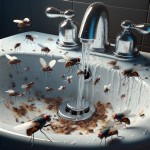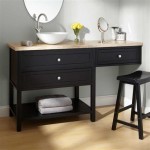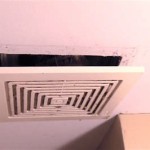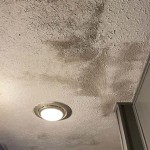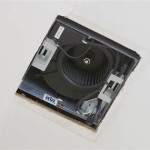Black Sludge in Pipe Bathroom Sink Drain: Causes and Solutions
A black sludge buildup in your bathroom sink drain is a common plumbing issue that can be unsightly and even lead to unpleasant odors. It's usually caused by a combination of factors, including hair, soap scum, mineral deposits, and bacteria. This sludge can accumulate over time, obstructing the drain and potentially causing clogs. Understanding the causes and taking appropriate steps to address the issue can help prevent future occurrences.
Causes of Black Sludge in Bathroom Sink Drains
The black sludge lurking in your bathroom sink drain doesn't appear overnight. It's the result of a build-up of various materials, each contributing to the unsightly mess. Here's a breakdown of the common culprits:
Hair and Soap Scum
Hair, whether it's from your head or your pet, is a major contributor to blockages. When combined with soap scum, which forms from the residue of soaps and shampoos, it creates a sticky, gooey mixture that clings to the drain pipes. This mixture traps other debris, leading to the formation of black sludge.
Mineral Deposits
Hard water, which is rich in minerals like calcium and magnesium, can leave behind deposits in your pipes. These deposits accumulate over time, creating a rough surface that allows hair and soap scum to stick more readily. This accumulation contributes to the formation of black sludge.
Bacteria
The moist, stagnant environment within your drain pipes provides an ideal breeding ground for bacteria. These bacteria feed on the hair, soap scum, and mineral deposits, contributing to the decomposition process that produces the black sludge. The bacteria also release foul-smelling gases, contributing to the unpleasant odor associated with clogged drains.
Solutions for Black Sludge in Bathroom Sink Drains
Addressing black sludge in your bathroom sink drain requires a multi-pronged approach. Here are some effective solutions:
1. Regular Cleaning
The best way to prevent black sludge build-up is through regular cleaning. This involves removing visible hair and debris from the drain strainer and periodically using a drain cleaner specifically designed to break down soap scum and other organic materials. It's important to use drain cleaners sparingly, as they can be harsh on pipes.
2. Hot Water Flush
Periodically flushing your drain with hot water can help loosen and dissolve some of the accumulated sludge. Pour hot water into the drain, allowing it to run for several minutes. You can enhance this method by adding a cup of baking soda followed by a cup of vinegar. The chemical reaction will help to break down grease and grime.
3. Plunging
If your drain is partially clogged, a plunger can be an effective way to clear the blockage. Make sure the plunger fits snugly over the drain opening and create a tight seal. Then, plunge up and down vigorously to try to loosen the blockage. If the plunger doesn't work, you may have a deeper clog that requires a different solution.
4. Professional Drain Cleaning
In some cases, the black sludge buildup may be too severe to address with DIY methods. If you've tried the above solutions and the drain remains clogged, it may be time to call a professional plumber. Plumbers have specialized tools and techniques to clear even the toughest clogs.
Prevention Tips for Black Sludge in Bathroom Sink Drains
Taking proactive steps can help prevent the buildup of black sludge in your bathroom sink drain. Here are some preventive measures:
1. Install a Hair Strainer
A hair strainer is a simple and effective way to catch hair before it enters the drain. Choose a strainer with fine mesh to ensure maximum capture of hair and other debris. Regularly clean the strainer to avoid clogging.
2. Avoid Pouring Grease Down the Drain
Grease and oil solidify as they cool, contributing to clog formation. Avoid pouring grease down the drain, even if it's already been cooled. Instead, dispose of it properly in a sealed container or recycle it.
3. Use Liquid Soap
Bar soap can break down into a slimy residue that contributes to drain clogs. Opt for liquid soap, which is less likely to leave behind a greasy residue. Moreover, consider using eco-friendly soap products with less residue.
4. Maintain Proper Ventilation
Adequate ventilation in your bathroom helps to reduce moisture and minimize the growth of bacteria. Ensure your bathroom has a functioning exhaust fan and run it during and after showers and baths. This will help to keep the air dry and prevent the build-up of moisture that encourages bacteria growth.
Addressing black sludge in your bathroom sink drain requires a combination of cleaning and preventive measures. By understanding the causes and implementing these practical solutions, you can keep your bathroom drains clean and functional for years to come.

What Is Black Sludge In A Sink Drain Birnie Plumbing Drains

What Is Black Sludge In A Sink Drain Birnie Plumbing Drains

How To Clear The Black Slime From Your Bathroom Sink

Black Stuff Coming Out Of My Sink Drain What Should I Do Mr Kitchen Faucets

What Is Black Sludge In A Sink Drain Birnie Plumbing Drains

How To Clean Black Sludge In Bathroom Sink Drains Hunker Cleaning Drain
Seeing Black Sludge In Your Sink Drain Here S What It Means

What Causes Black Mold In Sink Drains How To Get Rid Of It

What Is Black Sludge In A Sink Drain Birnie Plumbing Drains

Tiktok User Reveals The Grim Gunk That Could Be Lurking In Your Kitchen Sink Daily Mail
Related Posts


